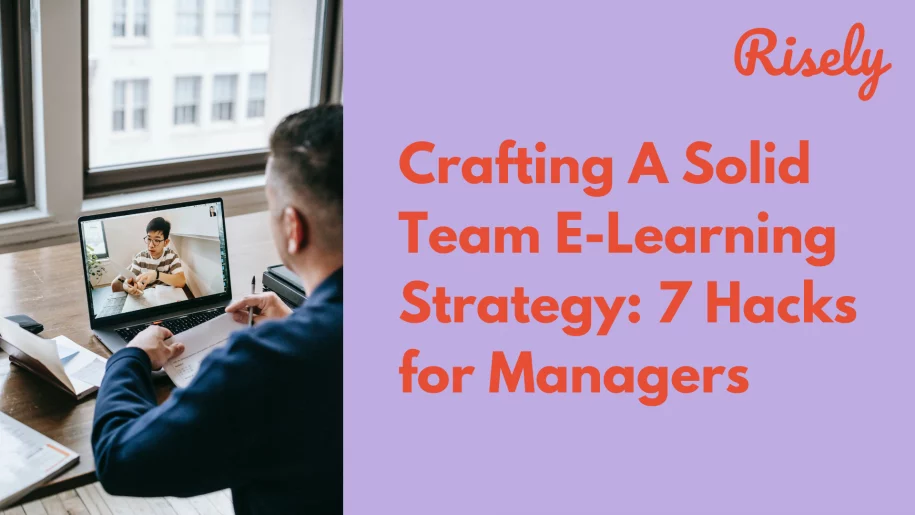Crafting A Solid Team E-Learning Strategy: 8 Hacks for Managers
Managing a team is tough, and ensuring each team member is on the same page regarding e-learning is even tougher. Crafting a solid team e-learning strategy can be daunting, but with the right tools and techniques, you can make it work. In this blog, we will discuss eight hacks for managers that can help you develop an instructional e-learning strategy supporting your team’s learning goals. We’ll cover everything from microlearning and mobile platforms to peer learning, gamification, and more. By the end of this blog, you’ll have a clear idea of what a good e-learning strategy looks like and how you can implement these strategies to create engaging courses that foster your learners’ active participation and promote personalized learning through adaptivity, quizzes, and insights.What does a good e-learning strategy look like?
E-learning is in vogue everywhere. But are you even getting it right? Here are a few things essential to a good e-learning strategy in the workplace.- Clear Learning Objectives: The strategy should define specific and measurable learning objectives aligned with the team’s goals and skill development needs.
- Engaging and Interactive Content: The e-learning materials should be visually appealing, interactive, and varied in formats (e.g., videos, quizzes, simulations) to maintain learner engagement and cater to different learning styles.
- Personalization and Flexibility: The strategy should allow learners to progress at their own pace and offer options for customization based on individual needs and preferences.
- Blended Learning Approach: A combination of e-learning and other learning methods, such as instructor-led training or peer collaboration, can enhance the effectiveness of the strategy and cater to different learning preferences.
- Continuous Assessments and Feedback: Regular assessments throughout the e-learning program help measure progress and provide timely feedback, reinforcing learning and addressing knowledge gaps.
Instructional E-Learning Strategies for Team Managers
In crafting a solid team e-learning strategy, defining clear learning objectives aligned with business goals is essential. Various instructional techniques, such as interactive elements, quizzes, and audio, can create an engaging learning experience that promotes retention. Incorporating a well-designed Learning Management System (LMS) or instruction strategies like social media or podcasts can be a great way to deliver practical corporate training. Managers must ensure the right environment for collaborative learning experiences while monitoring the online course material’s navigation and instructional design. Case studies can help achieve clear learning outcomes in any e-learning course. To sum up, there’s no one size fits all. But here are a few things that every manager can do to make their e-learning strategy successful:Implement Microlearning for Better Results
Microlearning is a learning approach that involves breaking down educational content into small, bite-sized chunks. These chunks are typically delivered through digital media such as videos, podcasts, or interactive modules and can be consumed in short bursts. Microlearning aims to make learning more accessible and convenient for learners, allowing them to fit education into their busy schedules. To successfully implement microlearning for better results, identify specific skills or knowledge gaps that require attention through this technique. Afterward, design the microlearning content accordingly to align with the learning objective of the learners. Ensure that the microlearning is readily available on various devices and encourage feedback from individuals who have gone through the process earlier.Supporting On-The-Go Learning via Mobile Platforms
In today’s digital age, mobile platforms have become an indispensable tool for e-learning. With the ability to provide on-the-go learning opportunities, these platforms enable learners to access bite-sized modules anytime, anywhere. To ensure that the e-learning content is easily accessible across devices and screen sizes, managers can use responsive design. Additionally, gamification techniques such as badges and leaderboards are a great way to keep learners engaged and motivated throughout the learning process.Encouraging Peer Learning for Better Collaboration
Improving teamwork in your organization requires a solid e-learning strategy that encourages peer learning. Collaborative learning fosters better communication among team members and helps them learn from each other’s experiences. To promote this strategy in a corporate environment, create opportunities for employees to share their skills and knowledge through group projects and presentations. Establishing a mentorship program where experienced colleagues can guide less-experienced ones is another great way to encourage collaborative learning. Recognizing and rewarding employees contributing to peer learning can also significantly enhance retention rates. Peer learning need not be boring either; there can be multiple ways to jab at it too:- Blended learning
- Social learning
- Collaborative learning
- Reverse mentorship

